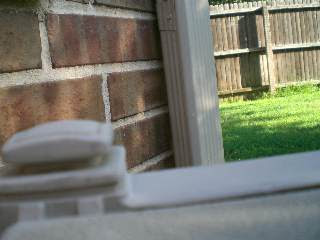Pikmin3D
 Friday, July 25, 2008 at 3:30PM
Friday, July 25, 2008 at 3:30PM Back when the Wiimote was first announced many came to the conclusion that the Wiimote would be perfect for a game like Pikmin. I find this comment a little strange. Sure, the Wiimote's pointer technology would make aiming quicker and more intuitive, but aiming was never a large issue in Pikmin. Generally, the player has plenty of Pikmin to throw at large targets. And after the Pikmin are thrown, they kick into auto pilot and take action to the nearest object. Furthermore, aiming and moving Olimar were two mechanics that were merged together. Like in Neo*RPG, the player aims and moves with the same pointing device which adds a bit of tension when moving away from danger and then turning around for an attack. For these reasons, I never felt the Wiimote could improve upon the design established in Pikmin 1 and 2 on the GameCube.
In order for the pointer capabilities of the Wiimote to significantly change how Pikmin is played, there must be more substantial targets to point at. This simply can't happen as long as Pikmin remains a 2D game. I know that Pikmin 1 and 2 are technically 3D games, but the top down perspective and flat level design makes the gameplay functionally 2D.
B.E.S is taking Pikmin in radical new direction. The 3rd dimension. Introducing...

- Traverse through both natural and domestic environments, and understand how the two interconnect to create a burgeoning ecosystem.
- Fully 3D level design. Slide under the floor boards. Climb up trees or drainage pipes. Sneak around canned food in the pantry. Drop down into shelves. The world is as much up as it is every other direction.
- Features a slightly pulled back 3rd person camera for moving around, and an over the shoulder view for giving orders.
 If this is Pikmin 1...
If this is Pikmin 1...
- Learn and use specific and intuitive Pikmin Sign Language by using the Wiimote and Nunchuck to give orders to your Pikmin.
- Employs a wide range of dynamic orders including: Go. Stop. Throw. Hold. Grab. Pull. Lift. Fight. Dig. Build. Destroy.
- Collect objects to help Olimar and the Pikmin master their environment. For example, a piece of string can be used as a bridge or a rope latter.
- Pikmin now have the ability to climb/walk along vertical surfaces like ants. Olimar does not have this ability.
- Completely organic level design. The world will no longer be a place that is so obviously constructed for Olimar and his Pikmin to romp through. The distribution and arrangement of objects/enemies will be as natural as possible.
- Features an ecosystem of interplay. Mess with one species, and you may slowly realize the damaging results to the balance of nature over the course of Pikmin days.
Pikmin3D is set in a game world that is split between the outside nature areas and the indoor domestic areas. Because these areas are designed with more realistic/natural geometry, the world will feature a lot of verticality. Unlike in Pikmin1 and 2 where the game world is mostly flat, Pikmin3D is designed to fully realize the power of volume.
With the Pikmin's new ability to climb up surfaces, large 3D obstructions can be interacted with in new ways. Though Olimar is limited to more traditional movement, for Pikmin walls become floors. This transformation of walls and space is analogous to how Super Mario Galaxy redefined 3D space by letting the player platforming around on what use to be untraversable areas.
Like in any real-time strategy game, positioning and moving through the environment is key. Because Pikmin can move in 3D due to the ant walk ability, Pikmin can be just about anywhere. For these reasons Pikmin3D is designed with full 3D definition.
By pulling in the camera close to Olimar, and even closer (over the shoulder) while giving orders, the perspective of Pikmin3D dramatically shifts to a smaller Pikmin-sized scale. This perspective gives Pikmin3D a level of scope that wasn't possible before. When the camera pulls over Olimar's shoulder, the player and Olimar's view points align. Because the newly designed 3D space also increases the draw distance of the game, the player is able to see much more of the environment at any given time. Due to the increased visability, Olimar is limited to only being able to control Pikmin that are in his direct line of sight. This means a low hanging leaf might obscure the Olimar's view and therefore his/her control over the Pikmin.
Remember how I described Mario Galaxy's acute definition of 3D space as being the culmination of 3 game elements (3rd person Mario, planetoids/objects/gravity, and the player's first-person starbit shooting) ? To achieve the upper levels of 3D space definition, the gameplay needs to revolve around the triangulation of 3 or more targets/perspectives. The more dynamic and various the triangulations, the deeper and better defined the 3D space.
The spatial triangle of Pikmin3D is composed of the Pikmin/targets, Olimar's perspective, and the pulled back 3rd person camera's perspective.
Bringing the scope of the game down to Olimar's level allows for the controls to be more precise and feature a greater range of effects. The Pikmin Sign Language is designed to utilize the true 3D controller that is the Wiimote and Nunchuck. Because well design motion controls are more dynamic and intuitive than traditional controls, Pikmin3D's Sign Language can effectively replace and expand the functions that were previously issued contextually.
The C-stick in the previous Pikmin games harbored quite a number of functions. By pushing it in any direction, Pikmin could be rallied to do battle, destroy objects, carry objects, build things, dig, or move into formation. As you can imagine, with all of these various functions on a single input the core design of the C-stick is cluttered with a significant amount of automation and contextual actions. When using the C-stick, you may often find that your Pikmin start doing one thing when you wanted them to do another.
By giving each command its own specific motion, the awkward overlapping of intent and automation is cleared from the core design. Using the pointer and the Pikmin Sign Language, orders are issued without confusion. Because each command/order is individualized, the controls can be tailored to match each action. For example, if you want a specific Pikmin to move forward just a little, just point at the specific Pikmin then motion forward in 3D space. Using the 3D Wiimote controller, moving the Pikmin forward feels like pushing it along in real life because of how the game space parallels actual space .
In the end, moving Pikmin into 3D not only gives the game a fresh new look, but it gives the core design a lot of breathing room. I intend on creating images to better illustrate Pikmin3D's new features. Until then, take a look around and try to imagine the world from the perspective of a Pikmin.






Reader Comments